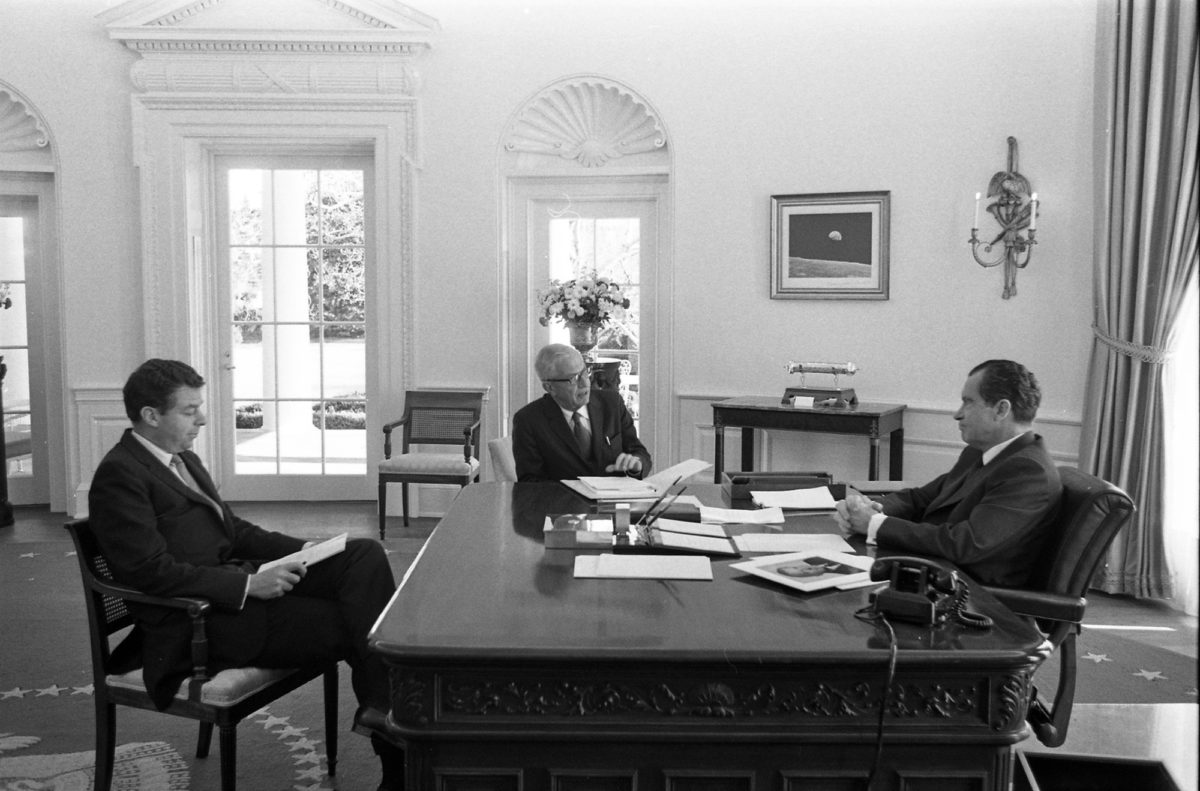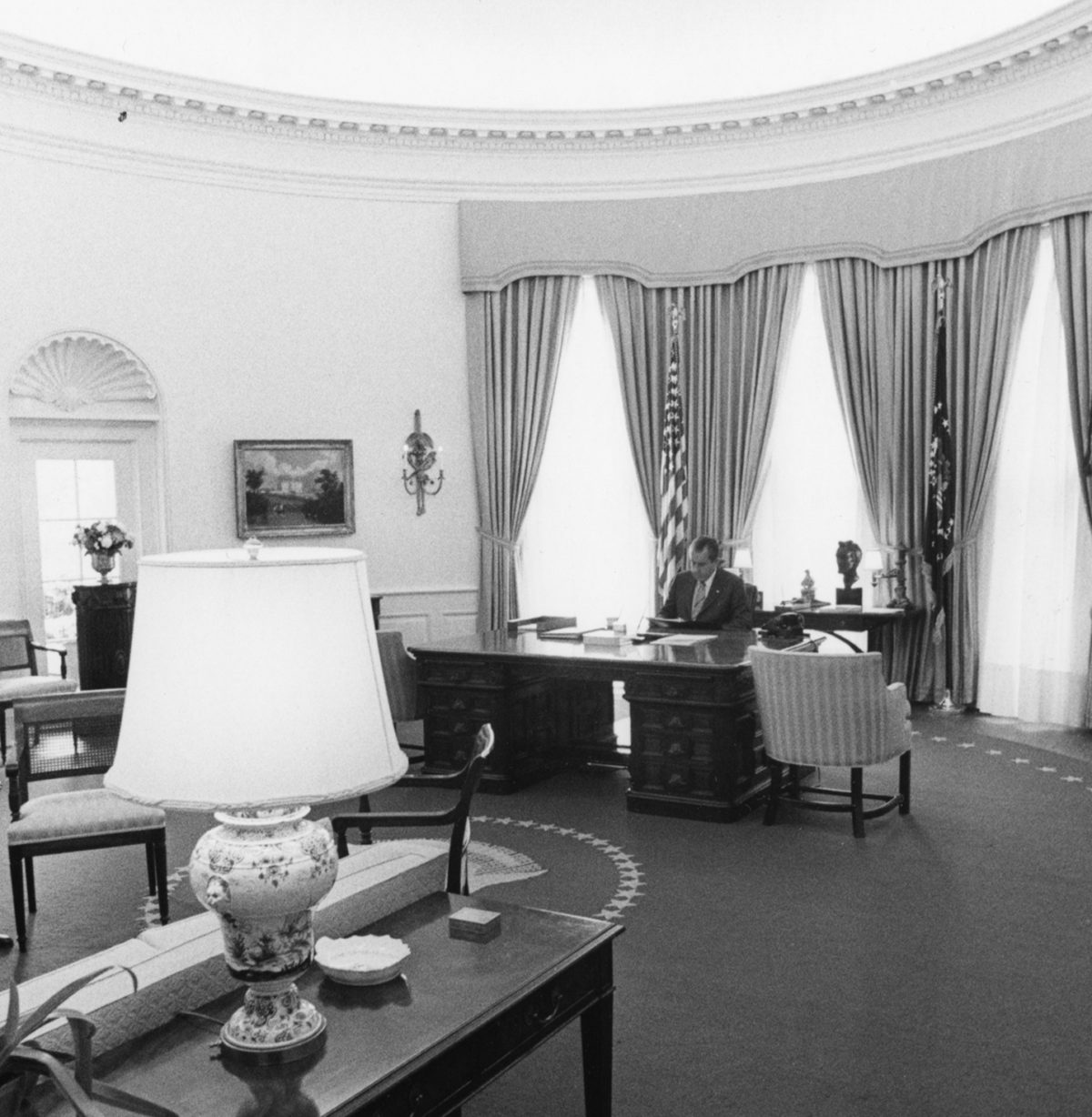John M. Logsdon • Oct 28, 2014
When Nixon Stopped Human Exploration
On October 4, Jason Callahan posted a blog here, titled “How Richard Nixon Changed NASA.” His blog was based on a talk I had given at the National Air and Space Museum in Washington. That talk was, in turn, based on my forthcoming book After Apollo? Richard Nixon and the American Space Program (Palgrave Macmillan, March 2015).
I gave a similar talk the next week at the International Astronautical Congress in Toronto; Bill Nye was in the audience there. One anecdote in the talk struck Bill as extremely symbolic of how the decisions made by Richard Nixon in late 1969 and early 1970 effectively ended human exploration beyond Earth orbit for the indefinite future. He asked me to capture that anecdote in a guest blog, and here it is.
In my Washington and Toronto presentations, I showed the photograph below. It was taken in December 1969 and shows Nixon at his Oval Office desk, meeting with science adviser Lee DuBridge (at end of desk) and Nixon assistant Peter Flanigan. Over Nixon’s right shoulder is the “Earthrise” photo taken by Apollo 8 astronaut Bill Anders on Christmas Eve 1968. Its presence in a prominent spot in the Oval Office seemed to indicate a positive Nixon attitude towards Project Apollo and space exploration in general.

Indeed, Nixon had fully embraced the success of Apollo 11 in July 1969, calling the seven days of the mission “the greatest week in the history of the world since the Creation.” He had become the first sitting president to attend a human launch, sitting through a rainstorm to see Apollo 12 lift off in November. But his enthusiasm for human exploration was short-lived; by December he was already telling his associates that he did not see the need to go to the moon six more times. Then came the near-tragic Apollo 13 mission in April 1970. Nixon became emotionally involved with the fate of the astronauts, fearing that future missions could result in astronaut fatalities. If he could have, Nixon likely would have ended Apollo flights then and there, but the image of quitting after a problem overrode that impulse. Nixon tried hard during 1971 to cancel Apollo 16 and 17, only to be talked out of that step by his advisors.
Not only did Nixon propose a premature end to exploratory flights to the Moon; he was not willing to take the next step, setting out on a path leading to Mars. NASA had proposed to the White House in September 1969 that post-Apollo space activities be focused on preparing for human missions to Mars at some point in the 1980s. Nixon and his associates decisively rejected that proposal as they cut the NASA budget in the months following the Apollo 11 and Apollo 12 successes. In March 1970, the White House issued a presidential statement on space saying that “what we do in space from here on in must become a normal and regular part of our national life and must therefore be planned in conjunction with all of the other undertakings which are also important to us.” This dictate set the space program in competition with other government programs for resources. It has not fared well in that competition; From 1970 onward, NASA has not had a budget adequate to support a robust program of human exploration.
This set of decisions was reflected in a very visible way. Here is Nixon alone in the Oval Office, in a picture taken in September 1970. The iconic Earthrise photo - a lasting artifact of human exploration - had at some point in the preceding nine months been removed from the office wall, replaced by a generic landscape painting. Richard Nixon apparently did not want to be reminded of what remarkable things human explorers could accomplish as he made the decisions that would keep humans in low Earth orbit for the next half-century.
Support our core enterprises
Your support powers our mission to explore worlds, find life, and defend Earth. You make all the difference when you make a gift. Give today!
Donate

 Explore Worlds
Explore Worlds Find Life
Find Life Defend Earth
Defend Earth


